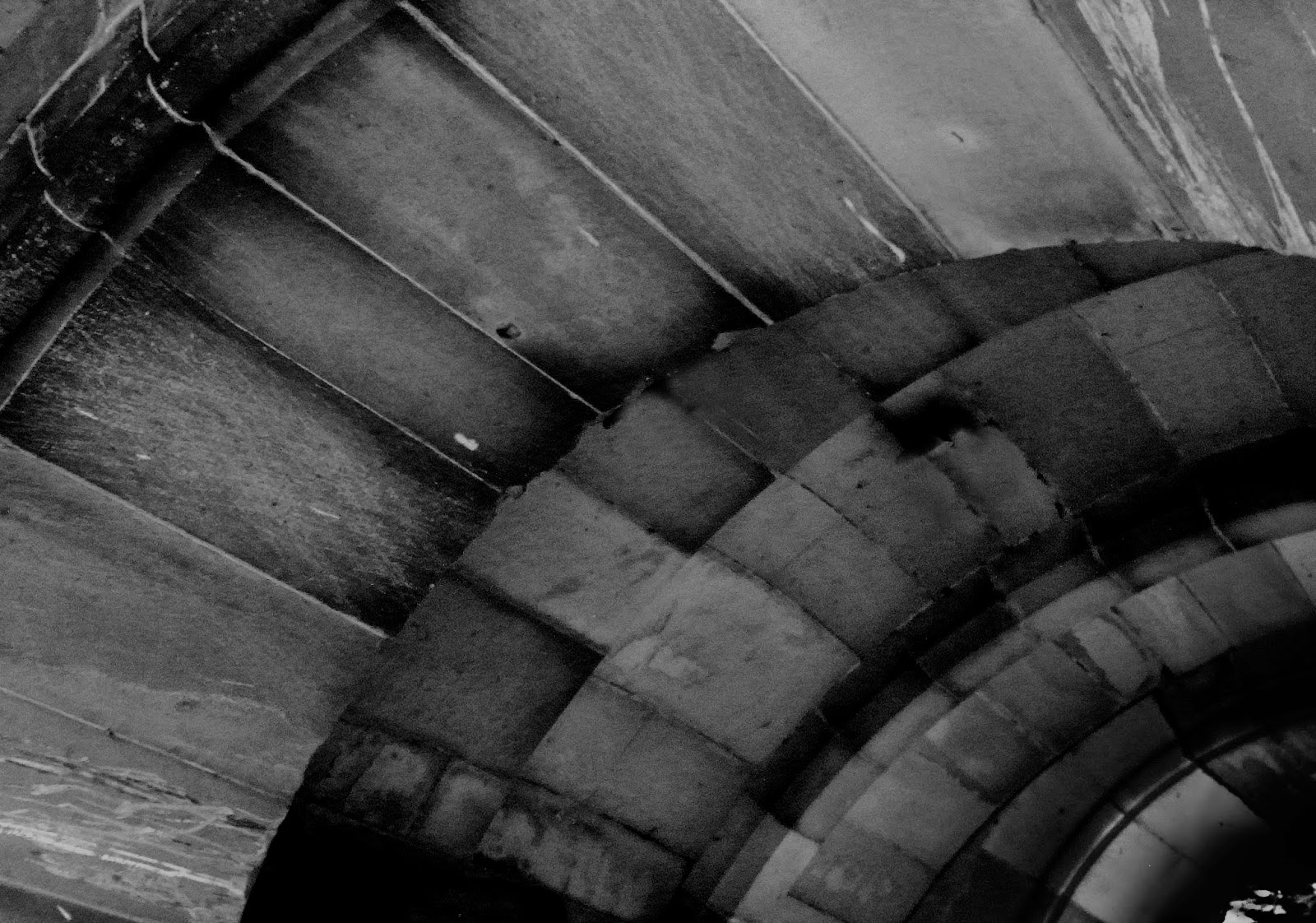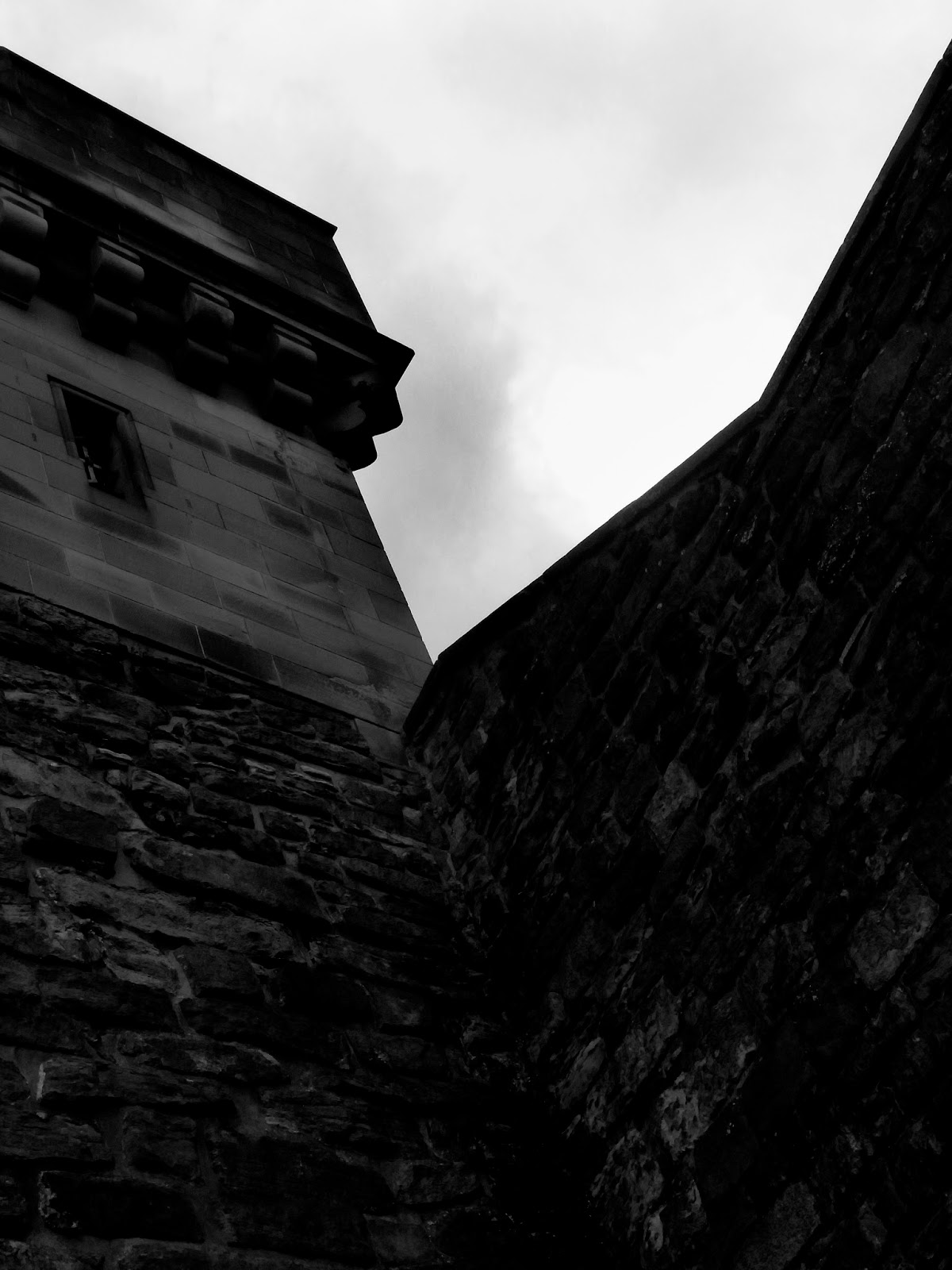So much of the rest of Edinburgh seems to have been built with at least some inspiration from the castle; all the castle-like details of the Scottish Baronial buildings that seem everywhere, the vistas that seemed planned to give you a good view of the castle, the gardens between Prince's Street and the railway that make the castle seem somehow separated from the city itself, etc. etc. Not many British cities still seem to have their old castle at their heart. Only Stirling, which also has its grand castle perched high above a steep rocky outcrop, seems to have some of this, but Edinburgh certainly seems built around its castle more than just geographically. Oxford, for example, still has its castle, but that castle has been swamped by the far grander buildings of the university and re-purposed so many times; it feels like it has been subsumed by its city.
 |
| Where the gates had once been underneath the Argyle Tower. |
 |
| Looking up to what is now the castle shop! |
Entry to the castle is not cheap. I think it cost me £16 just for myself. I then purchased a guide book, a few history books, post-cards and snacks all on top of that, making it quite an expensive visit. I am quite glad I had money saved up as otherwise I would not have ordinarily been able to afford such a trip. I think it is cheaper if you are a member of Historic Scotland - something I am seriously considering doing as I am quite fond of visiting historic sites (as visitors to my blog should know!).
 |
| Staggered walls of castle shop. Looking up at some clouds being interesting! |
 |
| Rear view of the shrine of the Scottish National War Memorial |
One of the more recent buildings is the Scottish National War Memorial, built over what, if I remember rightly, had once been both a barracks and a church at different periods. I don't know how much of the architecture is 20thC and how much is an adaptation of older buildings, but I do know that it is a place of reverence and remembrance. Photographs are not permitted in the Shrine itself, to preserve the dignity and attitude of reverence, but I can say that it is both somber and beautiful, with the names of the war dead from all three branches of the military kept in a metal box designed to resemble the Ark of the Covenant.
 |
| The archway, looking in from the approach. |
 |
| The same archway, this time looking outwards. |
 |
| The Royal Palace. At four storeys and with a tower, it's quite tall. |
Mary Queen of Scots gave birth in rooms in the older parts of the building, to the boy that later became King James VI of Scotland and I of England, and a few Kings later, Mary and William of Orange became King and Queen and it got complicated, Jacobites and Hanoverians fought over who would be King, and whether parliament could interfere in the succession and 'divine right of kings', quite literally with battles and suchlike, culminating in the Battle of Culloden (not to far from where I now live) in 1746. Politics then was more complicated than what you get in a George R.R. Martin book, and just as deadly, even if with fewer dragons. The depute head at the school I work at has tried explaining the complexities of the Jacobite uprising to me, but I must admit I lose track of which factions were on which side, and why, and the complexities of fractioning Christian sects of the time that underpinned a lot of the conflict confuse me utterly. As with most conflicts, I am at a loss as to why all of it should have escalated as far as lead to murder, death and battle.
 |
| I have forgotten exactly where this door is, but I think it is an entrance into what is now the Visitor's Information Centre |
Edinburgh Castle is on an ancient site, apparently used as some that could be fortified from as far back as the Iron Age, and still in use a while later, as Edinburgh is mentioned (as a large banner at the castle proclaims) in the Y Gododdin, some of the earliest Welsh poetry, as where warriors feasted for a year and a day before going off to die in battle. A quick hunt of the internet makes it seem an epic poem worth reading - in English translation for me, perhaps in modern Welsh for Raven. It's a lot of history; more than I could take in through only one visit; I'd have to read more books and visit a second time at least, to even start making sense of it all. A lot of the castle's history is military history as it was an army fortress for just about as long as Britain has had a proper army rather than just those called up to fight for local lords, and before that it was a fortification too. It's still a military place now, though now one of museums and offices, the annual Royal Military Tattoo (for those who don't know what that is, it's about marching bands, dance and pipers, not about getting inked!) and suchlike, rather than a working fortress. Military history is not really my area of interest (unless you count the 'Sharpe' novels by Bernard Cornwell. I'm pretty sure that does not count, though!)
 |
| I think this is the Argyle tower and junction with the top of the Laing Stairs, but I am not entirely sure. |
I enjoyed myself and I really enjoyed the architecture. It's a pretty large complex, the sort that brings to mind the epic 'Gormenghast' of Mervyn Peake, but less malevolent in architecture, yet with the slopes of the hill up to the crag all covered in old stone buildings, some more Gothic than others. I took so many photographs while I was there, but many of them ended up relegated to my discard pile. I hope you enjoy the exterior photographs here - later I will display some of the colour interior photographs. I think the autumnal grey of the weather just made the place seem colder and learning its conflict-ridden history just makes it seem a place full of the blood and sweat of warriors and soldiers from centuries past. The stones are greyed and the sky is greyer; monochrome photography seemed fitting.



These are such great photos! Really glad you posted these, and can't wait for the interior photos because sadly when we visited the city it was not something we budgeted for. And I love castles too!
ReplyDeleteI was planning to have the interior photos up today, but due to technical reasons, that might not happen until after the weekend. I am still laptop-wrangling!
DeleteI'll keep my eyes peeled! ;)
ReplyDeleteThey're finally up! The photos are not great quality; I am more an external photographer of buildings at the moment; interior photographs is something I need to work on.
Delete